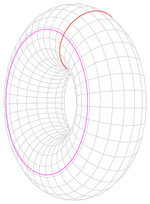Simply connected space
In topology, a topological space is called simply connected (or 1-connected, or 1-simply connected[1]) if it is path-connected and every path between two points can be continuously transformed into any other such path while preserving the two endpoints in question.Intuitively, this corresponds to a space that has no disjoint parts and no holes that go completely through it, because two paths going around different sides of such a hole cannot be continuously transformed into each other.The fundamental group of a topological space is an indicator of the failure for the space to be simply connected: a path-connected topological space is simply connected if and only if its fundamental group is trivial.is called simply connected if it is path-connected and any loop incan be contracted to a point: there exists a continuous mapare two paths (that is, continuous maps) with the same start and endpoint (at each point is trivial, i.e. consists only of the identity element.[2] In complex analysis: an open subsetThe set of complex numbers with imaginary part strictly greater than zero and less than one furnishes an example of an unbounded, connected, open subset of the plane whose complement is not connected.Informally, an object in our space is simply connected if it consists of one piece and does not have any "holes" that pass all the way through it.For example, neither a doughnut nor a coffee cup (with a handle) is simply connected, but a hollow rubber ball is simply connected.In two dimensions, a circle is not simply connected, but a disk and a line are.The definition rules out only handle-shaped holes.A sphere (or, equivalently, a rubber ball with a hollow center) is simply connected, because any loop on the surface of a sphere can contract to a point even though it has a "hole" in the hollow center.The stronger condition, that the object has no holes of any dimension, is called contractibility.A surface (two-dimensional topological manifold) is simply connected if and only if it is connected and its genus (the number of handles of the surface) is 0.Take for example the complex plane under the exponential map: the image isThe notion of simple connectedness is important in complex analysis because of the following facts: The notion of simple connectedness is also a crucial condition in the Poincaré conjecture.


topologytopological spacepath-connectedfundamental groupunit circleunit diskEuclidean planehomotopyidentity elementmorphismsfundamental groupoidcomplex analysisRiemann sphereconnectedspherehandlecontractibilitysolid torusn-dimensional sphereconvex subsetcylinderMöbius stripprojective planeKlein bottletopological vector spaceBanach spacesHilbert spacesspecial orthogonal groupspecial unitary grouplong linemanifoldcovering maphomotopy equivalentCauchy's integral theoremcomplex planeholomorphic functionantiderivativeline integralRiemann mapping theoremconformally equivalentPoincaré conjectureDeformation retractLocally simply connected spacen-connected spaceUnicoherent space